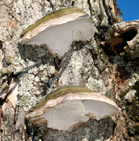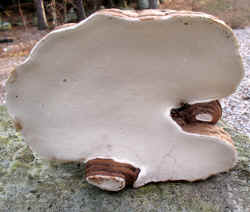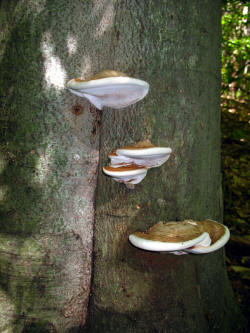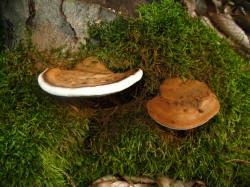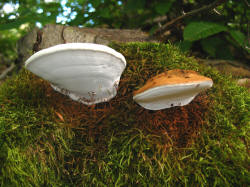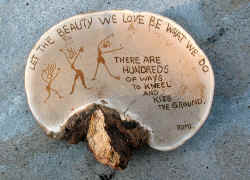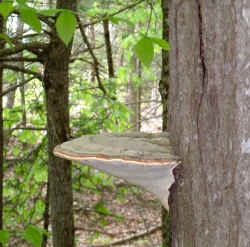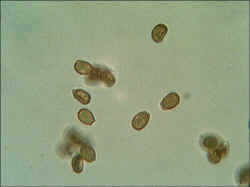|
|
A New England and Eastern Canada Edible and Medicinal Mushroom Resource |
||
|
Artist's Conk Artist's conk is exceptionally common in Maine growing on older sugar maples and many other hardwood trees usually persisting for years. When they are picked the interior reveals layers of pores that are like rings on a tree in describing age. Artists use these mushrooms for etched designs when fresh and for landscape and other painting when dried. They can be displayed differently than most paintings because the mushroom will stand on it's edge on a table or shelf. They become almost as hard as a block of wood and will last for many years. There is some scientific evidence developing that indicates this mushroom has some antibacterial properties. Cap (pileus) 4- 24 in. across and fan or kidney shaped, slightly convex to hoof shaped. They can have zones, bumps, lines or cracks and are exceptionally hard especially after the first year. The cap is usually gray in the off season and brown in the summer when covered with spores. It can become several inches thick as it ages. Pore The pores/tubes are white bruising to brown if touched or bruised. A new layer of pores from 1/4 to 1/2 inch thick is built each successive year. Stem (stipe) Usually not present broadly attached to the wood and quite difficult to remove. Flesh Very hard and brown or brown and white. Spores The spores are brown and tend to collect on the top of the cap in summer. When and where to find them (ecology) These are very easy to find on mature or dead hardwood. Often near streams can be a good place to look because there tends to be more dead wood and a moist microclimate. Sugar maples that are on their way out are very likely to have them. They are everywhere actually. They have a strong but pleasant woodsy smell. Preparation: Artist's conk is inedible as food but can be made into a tea or tincture. As always try a small amount at first. If you have health issues or take medication there is a possibility of interaction. Check with your doctor. Artist's conk contains polysaccharides and triterpenoids that have various medicinal implications. They can be made into a medicinal tea by drying them thoroughly and grinding them with a meat grinder or other type of grinder. They may put a quick end to the life of your blender unless you have a really good one. Comments If collecting for doing art work please note that they need to be removed very carefully. You may need a hatchet for a harder older specimen but often you can push down hard from the top and loosen them. You may have to push in several places and it is best if it does not come off all at once dropping to the ground as it can be easily bruised that way. You want to try to ease it off. You should not touch the pore surface in any way or it will bruise damaging your "canvas". It must be carried and stored in a way that the pores touch nothing. It may be etched using techniques similar to conventional dry point etching while still fresh for a sepia colored design or it may be painted after drying when the pore surface becomes hard and is not so delicate. If you pick them in winter the pore surface will be hard and will not be successfully etched but it can be painted. Artists Conk has a strong fragrant smell. For some reason cats can be too interested in the smell of fresh specimens. Artist's conk can be used for dyeing wool, some fabrics, or paper and will yield a rust color with wool when ammonia is used as a mordant. The red-belted polypore (Fomitopsis pinicola) looks quite similar but often has darker blackish or green tones on the cap and a red or maroon band near the outer margin. It has whitish flesh and white spores. It will usually be found on pine or hemlock but sometimes grows on hardwoods. It may be used as a "canvas" like the artist's conk but it bruises/etches more yellowish. The pores often yellow somewhat when dried. Red-belted polypore can be quite large and thick. See below. Find more information here: Ganoderma
applanatum at MushroomExpert.com
Use of this site will constitute your acceptance of the disclaimer. Copyright 2012 Mushroom-Collecting.com. All rights reserved. |
